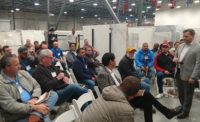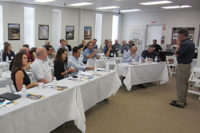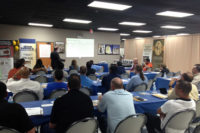The 2017 stone education series — organized by MIA+BSI: The Natural Stone Institute and Stone World — made a stop in Memphis, TN, for the first time and the results were extremely positive. The all-day event, which was hosted by Pacific Shore Stones, drew 28 fabricators from 18 different companies.
According to Aaron Danke of MIA+BSI, Memphis was an ideal location because of it close proximity to other states, such as Mississippi, Arkansas and Missouri. Additionally, Memphis itself has quite a few fabrication facilities and those MIA+BSI spoke with expressed gratitude about a Stone Summit coming to their region.
The educational session was led by GK Naquin of Stone Interiors North America, a large fabrication company with four locations in the Southeast — two of which have received the MIA accreditation credential. Naquin won the 2005 Stone World Fabricator of the Year Award and served as the 2011 president of the MIA and Board of Directors.
Before getting into the nitty gritty of stone fabrication, as well as the management issues that come along with running this type of business, Naquin asked attendees to introduce themselves, give a brief description of their company and explain his or her expectations of the workshop. He encouraged audience participation and told attendees not to hesitate to ask questions. They will get out of the session what they put into it.
Know your expenses
The morning discussion kicked off with metrics. Naquin emphasized the importance of knowing the average of what it costs to fabricate a job. “It’s the bottom line — the cost to fabricate, measure and install,” he said. “It’s the sustainability of your company. If your company fails, it’s not only you, but everyone’s job goes out the door. It’s your responsibility to keep everyone employed.”
Naquin asked the audience if they know what their overhead is. “It should be around 20%,” he explained. “When you shoot for your profits, you should be around 35 to 45% gross — before overhead. It’s material cost, labor cost; it includes depreciation on your CNC, pick-up truck — anything related directly to fabrication/installation. If you are hitting 35%, then you are pretty much in a range you can make 6 to 10% net profit a year. Then you want to shoot for a 10% net profit. That’s what I consider sustainable. 6% is the minimal, otherwise you are spinning your wheels. Those not making that, you need to start looking at why you aren’t making that.”
Naquin also stressed the importance of educating your sales staff. “Sales people have to know it takes twice the time to run quartzite through a machine than granite,” he said. “They have to know that is why it is priced higher. They need to know an undermount sink in a Dekton or Lapitec countertop will cost a whole lot more than a surface cut out.”
The discussion then led to working with home builders. “My sweet spot is my builder because I don’t have to have the service component behind the builder as I do with the retailer,” said Naquin. “I have a builder program for custom home builders in our region. Builders are never as loyal as they pretend they are. Their purpose is to build it cheaper. The builder market is one of my lowest-priced markets because they do bring me repeat business.
“I layer my price structures based on my clientele,” Naquin continued. “My miter edge for a builder is different than my miter edge for a retailer. We offer a ‘package.’ You can minutely tweak prices to get a little more money out of the job. With retail, I am involved in the job more. There’s more detail. An ogee edge on a CNC costs nothing, so charge a little more than a flat edge. Don’t sell ogee edges though if you don’t have a CNC because then it takes you a lot more time than a flat edge.”
Hiring and retaining employees
When a group of fabricators gather, lately it is not uncommon for the topic of employees to surface. “In 2008, we lost a whole lot of people in our industry,” said Naquin. “In our Alabama shop, we had 75 and we went down to 18 in each location. We are now starting to grow again. The guys we had let go have repositioned themselves with oil companies, etc. because they were talented people. We are now trying to find people.”
One participant suggested the three things to look for when hiring a new worker include assessing if they can physically do the job, if they can learn and can they show up on time. The conversation then turned to who do you turn to in times of a crisis. “What do you do if you are all digital and your machines go down?” asked an attendee. “You still need to get it done.”
Naquin explained you do need to plan for emergencies. “You need to have someone in your area you respect and can help you out — someone who would cut during their night shift,” he said. “I still have a bridge saw in our shop. I’m just saying it’s not necessary.”
There was some rustling in the audience during this talk. One participant said she doesn’t like other fabricators the area and wouldn’t trust them. Naquin reiterated members of the stone industry need to learn from each other. “The reality is to be friends,” he said. “Understand, they are in business like you.”
Breakout groups
After lunch, participants were separated into several breakout groups to discuss topics of specific interest to them. In the “technology” group, fabricators wanted to know what blades each other were using to cut quartzite and ultra-compact surfaces. They also discussed ways for sharpening blades to prolong their life.
Another topic that rose during the discussion was how to handle working with faucets. The fabricators asked each other if they are drilling faucet holes with a CNC or on the jobsite? Most agreed it is better to do it in the shop, but make sure to get the specific details about the faucet from the homeowner.
Those who got together to talk about sales and marketing shared experiences and frustrations with online reviews. While positive reviews are beneficial, how do you handle the negative ones? The consensus was to respond immediately. This will demonstrate that you care that your customer wasn’t satisfied and want to rectify the situation.
Moreover, Google ad words were talked about. Some of the fabricators think they are a good way to reach out and get detailed feedback. The group also discussed community efforts. Potentially sponsoring little league teams is a nice way to let people know who you are. They also thought blogs are a good way to reach out and educate consumers.
On the administration side, the group discussed the importance of communication within your organization. If you have forms your employees aren’t filling out, it falls on the shop owner. The group believes it is necessary to communicate your expectations as an employer. Make your employees understand they need to do what you need them to do.
Several in the group said they receive a great deal of applicants through Facebook. They also discussed implementing a program to reward employees for not having a callback.
Following the Memphis Stone Summit, there were sessions held in Chicago, IL, and Baltimore, MD. The next one will be held in Livermore, CA, on Thursday, June 22. To learn details about this event or see if there will be one coming soon in your neighborhood, visit www.stoneindustryeducation.com.









